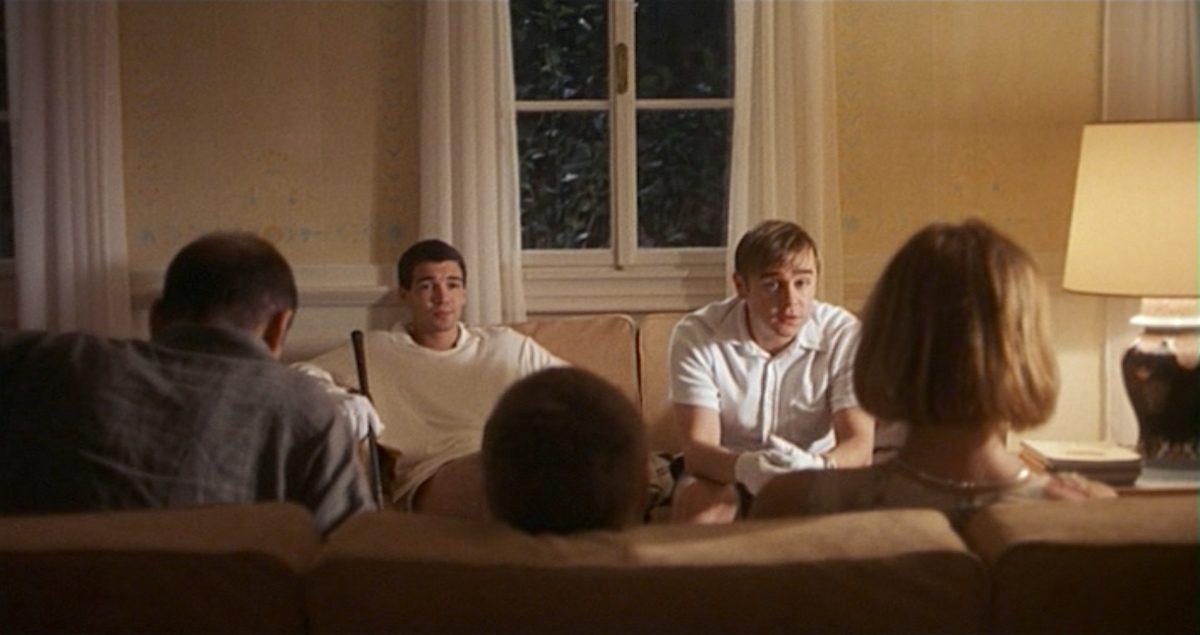May 1997. Austrian director Michael Haneke is preparing to show his new work at the Cannes Film Festival in France. Despite having directed three films before, Haneke is hardly a household name. With this one, however, he might make history. Anticipation builds as the audience gets settled to watch the debut of “Funny Games.” What the audience doesn’t know yet is that one-third of them will leave before the film is finished.
The film opens with a game of guess-that-composer, accompanying a long aerial shot of a car hauling a boat behind it. Once the family inside is finally revealed, so is the title card. And so is the true nature of the film. After two and a half minutes of classical music and peaceful shots of a road trip, the scene is interrupted with a red text overlay and loud, intense metal music. This will prove to be the energy the film carries throughout its entirety.
Over its almost two-hour run-time, “Funny Games” ruthlessly and unapologetically shows the experience of a family who became the target of two men who have a strange fixation on childhood games – games like hot and cold or hide and seek, but with a dark twist. The men torture the family of three with their games, with no end in sight. The violence is long, drawn out, and deeply disturbing.
Nothing like any film before it, “Funny Games” made history with its narrative choices, fourth wall breaks (more on that later), and violent content. 26 years later, a more traditional horror film came out in theaters. The Argentinian flick “When Evil Lurks” (2023) is without a doubt just as, or more brutal and gory than, its predecessor, “Funny Games.”
The story follows a community of people as they learn that one of them is infected with a demon. The practical effects used to show the infection are horrifyingly realistic and cover-your-eyes gross. Throughout the film, this rings true. Not just to gross out the audience with pus, spores, and excess fat, but to show much more disturbing scenes. The outright gore and violence are depicted with no discrimination. Children, animals, and the old… it doesn’t matter, this film does it. And shows it.
Also Read: How Haneke plays with the audience’s expectations in ‘Funny Games’
Something these films have in common is that you can Google “[Title] dog scene” and be met with something that might bring you to tears. Their bigger similarity, though, is their ruthless and insensitive violence. However, something they don’t seem to share is their critical response. “Funny Games” got a harsh response from critics and viewers.
Claiming the film was too violent and the torture was senseless, the film received scathing reviews upon its release. In 2023 and 2024, “When Evil Lurks” received 22 nominations and 8 award wins at film festivals all around the world. For its creativity, special effects, and direction, “When Evil Lurks” was a universal hit.

Where is the line? Why did “When Evil Lurks” receive such a different response than “Funny Games,” despite being far more gory and violent? You could say that the times have changed. Since 1997, society has become more accepting when it comes to the portrayal of violence. We have seen countless movies where the dog dies or a child experiences some horror. Perhaps we are simply desensitized to it. Or you could say it’s realism that draws the line. Not realism in the sense that the violence looks real, or there’s a lot of blood.
Realism meaning: Could this happen to me? Although both stories are completely fictional, the crux of “When Evil Lurks” is supernatural and deeply religious. “Funny Games,” however, is disturbingly realistic. No other-worldly or supernatural force is responsible for the horrors that take place on screen.
Instead, two men caused all that violence and terror. Two men who could knock on your door next. Realism, in this sense, makes the violence all the more disturbing. Or maybe you could argue that it’s the tone that sets the two apart. One is clearly more darkly comical than the other; the mocking tone could make critics uncomfortable. “Funny Games” makes light of real-life tragedies, although the film itself is fictional.
Finally, it could be the intention of the director. The goal of sitting down and watching a film like “When Evil Lurks” is to, ultimately, be scared. You want to be scared of the story, the gore, the violence, and the evils on screen. What you don’t want is to be confronted with the real-life evils. What makes “Funny Games” unique is its purpose.
An essential piece of the film is its self-awareness. While being very ruthless and gory itself, the film’s goal is to satirize the senseless gore and violence of American horror films. It features multiple fourth wall breaks where one of the men turns to the viewer and communicates directly with them. In one instance, he winks, making a joke out of his victim’s pain and letting us in on it. In the most memorable fourth wall break of the film, he pulls out a TV remote and rewinds in order to get the outcome he wants.
By winking at the audience as if we are on their team, the villains of the story aren’t as far from us as we would like. Instead of simply watching them, the audience suddenly becomes partially responsible for their actions. But… what’s the difference between taking part in the horrors and watching them happen for entertainment’s sake? Haneke asks the question: why do you wish to be scared by these stories, but do not wish to feel any responsibility for them? Which may be the reason Michael Haneke said that walking out of the premiere may have actually been the most moral response to “Funny Games.”
When does the scare feel too real? When does it become the audience’s responsibility? When watching a traditional American slasher like “Terrifier” (2016), you may be scared, but not burdened. You aren’t confronted by the choices of Art the clown because you aren’t affiliated with him; he is a reckless clown who will torture his victims. There’s nothing you can do about it… so why not watch? For the purpose of being scared. For the purpose of being entertained. Isn’t that the point? And isn’t “Funny Games” still entertaining at the end of it all?






